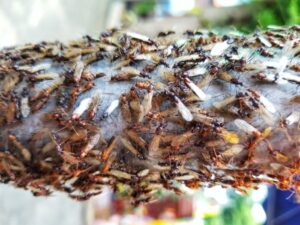What are Termite Swarmers?
One of the most common signs of a termite infestation is the sight of termite swarms, perhaps around your porch light or perhaps flying in your yard. You might also spot discarded wings on your window sills and around your door frames, letting you know that a termite swarm has been there. But what are termite swarmers? Are they a particular species of termite? Here, we’ll explain termite swarmers, why they swarm, and what you can do to keep them out of your home.

To understand termite swarmers, you need to know a little bit about termite behavior. Termite colonies have a highly structured social system, with a king and queen reproducing and their offspring initially becoming workers and soldiers. Soldiers protect the colony, while workers do, well, the work. They build and maintain the tunnels of the nest, forage for food, tend to the young termites, and feed the king, queen, and soldiers. Once the colony is well established, some of the young termites grow into reproductive termites, called alates. These alates grow wings and fly off in a swarm, looking for mates with whom they can establish new colonies. Once they’ve paired off and found a suitable spot to build a new nest, they drop their wings and get to work.
Here’s the really bad news: termite swarmers are weak flyers that can only fly about 300 feet from their original colonies. If you see swarmers, then, you’ve already got a termite infestation on your property. While the termite swarmers are seeking a new place to form a colony, the workers will continue to eat wood, most likely damaging your home. Once a pair of swarmers find a place that’s the right temperature, with the right amount of moisture and food, they settle down to become king and queen of a new colony. The queen immediately begins to lay eggs, and the colony begins to grow. Now you will have two termite infestations on your property, one established and one new.
A few months after the swarm, the first generation of offspring from that king and queen has matured, and they begin to care for the subsequent generation. After several months, there will be a few hundred termites in the new colony, and the numbers will continue to rise. By a year or two after the swarm, the queen will be laying up to 10,000 eggs each year, the workers will have established themselves, and feeding will be happening in hidden areas. In three to five years, the colony will be fully mature, ready to send off new swarmers. How long can this cycle continue? A termite queen can live 30 years or more, and when she dies, another reproductive termite will step up to take her place. In other words, a termite colony can survive almost indefinitely. That’s why it is imperative to get ahead of termites before they can destroy your home.
When is termite swarming season? If you live in California, you’re likely to see termite swarms year round. This is because of California’s hospitable climate, as well as the fact that several different species of termites live in this state. You cannot count on swarmers coming out only during one season, so you must have termite prevention measures in place throughout the year.
- The first step in termite prevention is inspection. You can inspect your own home, looking for signs of termites. These include not only swarmers and their wings, but also mud tubes on the walls, particularly outside your home, damaged wood, pinholes in wood, and termite droppings, known as frass, that look like sawdust or sand. You might also notice spots in your house where the wood feels soft or sounds hollow. While you can sometimes spot these on your own, it’s often only after significant damage has been done that you’ll notice them. A better strategy is to have a professional termite inspection once a year.
- Keep excess water away from your home. Outside, water should drain away from the house and not pool around the foundation. The gutters should be cleaned, and the downspouts pointed far enough away that water doesn’t flow back toward the house. Inside, fix any leaks promptly to make sure you’re not creating a welcoming environment for termites.
- Be careful with wood. Replace any damaged or damp wood on or around your home, and don’t allow the wood to touch the house. Trim back your foliage, and don’t leave wood scraps in the yard, or use wooden mulch around your foundation. If you store firewood outside, keep it away from your home, off the ground, covered, and dry.
- Seal any cracks or crevices immediately. You don’t want to give these tiny insects an easy pathway into your home.
- Call a professional if you see any signs of termite activity. A good termite control company can provide termite treatment to get rid of any termites in your home, as well as help you establish termite prevention strategies to keep them off of your property.
It’s time to call the termite control professionals at MightyMite Termite Services. At MightyMite, we’ve earned a reputation as experts in California termite control. We perform termite inspections to ensure that your home is free of termites and work hard to help you keep it that way, using treatments that are naturally derived and have a low impact on the environment. We diagnose and treat infestations with the most effective methods and unmatched warranties, solving your termite problems the first time, with an industry best “no call-back rate.” That, combined with our experience, technology, and highly trained professional staff, makes us the leading extermination company in the Bay Area. We understand that your home is your most important investment, so we work hard to provide excellent service, utilizing best practices to solve our customers’ termite problems. For more information, email Info@mightymitetermite.com, call us today at 408.335.7053, or contact us through our website.
